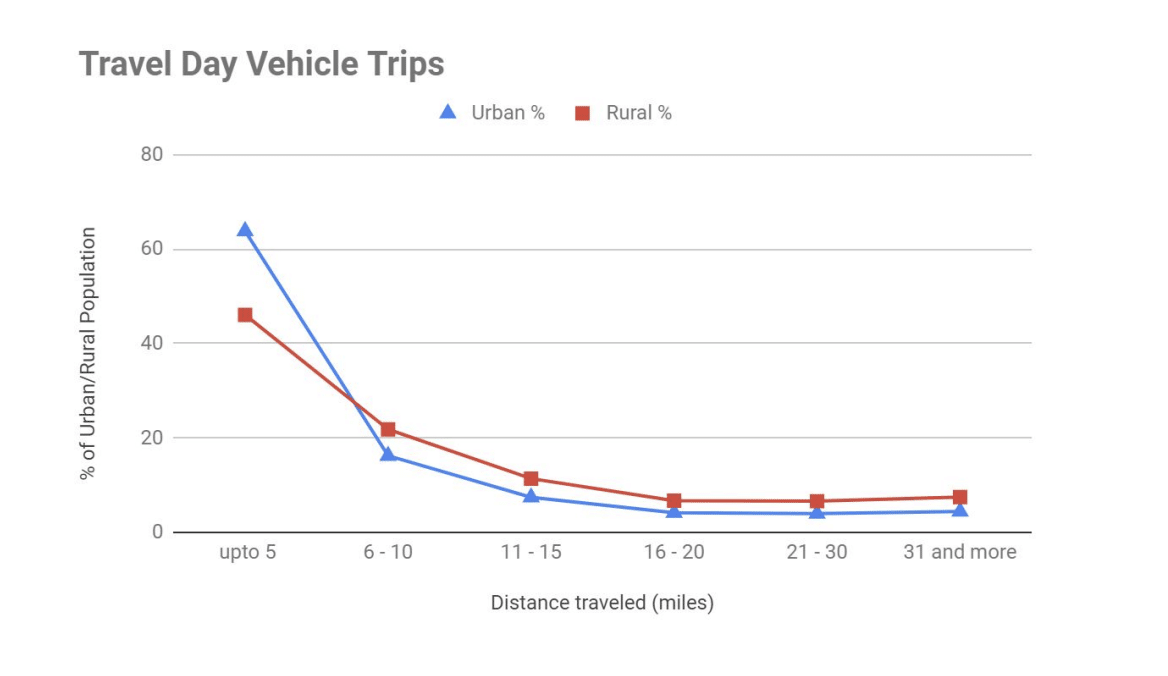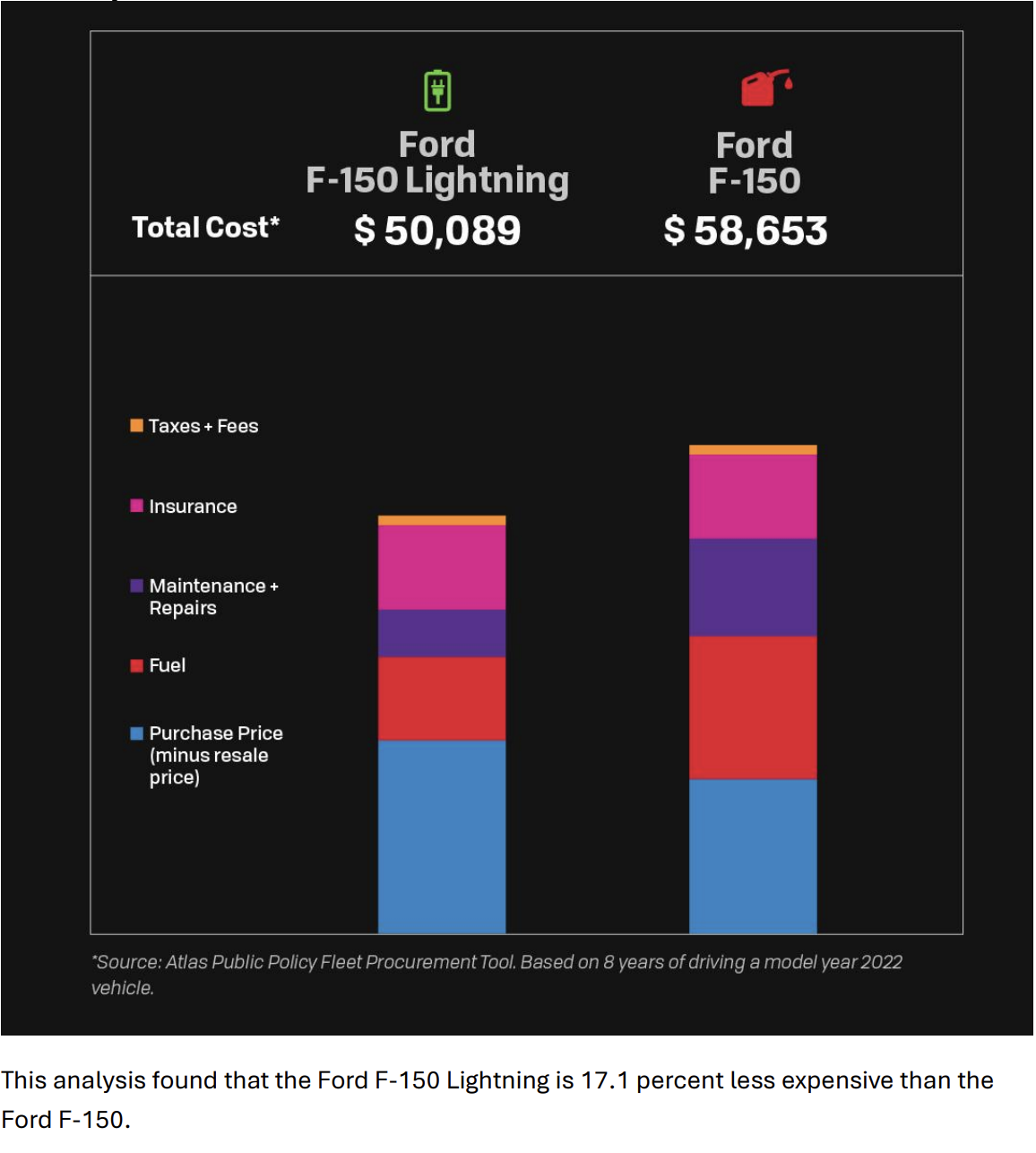Rural communities are distinct from urban areas in many ways. To ensure that none are left behind as we electrify transportation, we must address their unique mobility needs.
Guest Blog | April 14, 2022 | Clean Transportation, Electric Vehicles, Energy JusticeThis blog post was written by SACE’s former Electric Transportation Equity Manager, Patrick King.
Mobility needs are not created equally, and addressing them should not be one size fits all. My recent blog post explored the characteristics of the urban environment and the effect transportation electrification could have on existing inequities. Rural communities’ geography and driving habits require different considerations and solutions to ensure that these communities are not left behind in the transition to electrifying transportation.
Characteristics of Rural Communities

Rural drivers, on average, are more likely to take longer daily trips (10 miles more than their urban counterparts) and live further away from healthcare services, employment opportunities, and recreation. This increase in driving and geographic distance from necessities also burdens rural drivers with increased transportation costs. Typical rural drivers spend about 44% more on fuel and spend a larger share of their household budget on transportation. Rural America also has a higher percentage of residents living below the poverty threshold – 15.3%, compared with 11.9% nationwide – and a lower per capita annual income. Of the vehicles on the roads within rural communities, there’s a higher likelihood that they’re older, less fuel-efficient models, which only exacerbates the added costs. With few to no public or alternative transportation options, this cost is keenly felt by lower-income families and elderly residents on fixed incomes. Recent reporting from the National Consumer Law Center highlights these issues and offers up compelling policy solutions through an equity lens.
Expanding Education and Awareness
To date, the majority of EV adoption has taken place in large metropolitan areas. Historically, most electric transportation outreach has focused on urban areas due to the battery ranges of early market models and the shorter trips that urban drivers make. But battery ranges have made significant improvements in recent years, and the median range for the model year 2021 vehicles is 234 miles. Likewise, we’re beginning to see a shift in efforts to engage rural stakeholders.
For example, in Hood River, OR, Forth Mobility operates the Clean Rural Shared Electric Mobility (CRuSE) Project, a community carsharing program that provides residents and tourists with access and firsthand experience with EVs. Here in the Southeast, there are similar initiatives such as Tennessee Tech’s ongoing Rural EV Demonstration. Rural utility providers are also helping spur adoption through efforts such as North Carolina’s electric cooperatives; which offer a wide variety of benefits and incentives to customers including low-interest loans and rebates for purchasing EVs.
Lack of Desirable Models and Dealership Promotion
Given the ongoing volatility in the global fossil fuel economy, many folks are already considering the switch to an EV, but when they begin to shop around, many experience a disconnect at the dealership: a 2019 report from Sierra Club found that 74% of dealerships nationwide don’t currently offer EVs. Of the ones who, many only had one or two on the lot, and sales staff were misinformed about charging battery range and consumer incentives. The report did find that 25% of dealerships with at least one EV on the lot offered both used and new vehicles, which bodes well for the growing used EV market.
Likewise, until recently, the lack of diversity among models available to consumers may have negatively impacted EV adoption among rural consumers. According to Car and Driver, the most popular model of vehicle sold last year in the U.S. was the Ford F-series pick-up truck. There has yet to be a mass-produced pick-up model available on the EV market, but that’s poised to change this year with several models coming online, including the all-electric Ford F-150 Lightning, Rivian, and Chevy Silverado, among others. As an aside, there is currently a plug-in hybrid F-150 on the market, and during 2021’s deadly winter storms in Texas, some owners were able to use the vehicles to power their homes. This is an exemplary use case of the applications of EV technology that also has the power to turn folks who are on the fence to advocates.
Affordability
When we consider the lifetime ownership of a vehicle, EVs are already the clear winner and can save consumers several thousand dollars. A study by M.J. Bradley and Associates and the Union of Concerned Scientists revealed that the lifetime savings of EVs for rural drivers could be higher than their urban counterparts. Electricity as a fuel source is much cheaper than fossil fuels and less prone to dramatic price fluctuations. Furthermore, repair costs for EVs are about 50% lower than conventional gasoline-powered vehicles and have fewer parts that require regular replacement (sparkplugs, oil & transmission fluid, air filters, & etc). Despite all of these long-term savings, upfront costs remain a barrier to large-scale electric vehicle adoption for many Americans, rural residents included. This issue is shifting as decreasing costs of batteries continue to bring the upfront costs of EVs down and price parity with internal combustion engine vehicles is expected in the coming years. Currently, the federal government is offering substantial tax credits for new EVs ranging from $2,500-$7,500, depending on the model and battery capacity. Additionally, improving state and local utility EV incentives will help improve affordability for low to moderate-income households.
Charging Stations
Given, or possibly due to, the lower rate of adoption of EVs in rural areas, it’s not surprising that much of the charging infrastructure has also been concentrated in major cities in states with higher urban populations. This lack of infrastructure, in turn, perpetuates ongoing barriers to rural EV adoption. There is significant federal funding intended to address this problem coming down the pike in programs such as the $5 billion National Electric Vehicle Infrastructure (NEVI) Formula Program. In addition, many states across the Southeast, such as North Carolina, are proactively leveraging their VW settlement funds to support rural charging infrastructure programs, specifically targeting under-resourced counties. These historic investments are especially timely as rural populations have been dropping as our country becomes more urbanized. This population shift represents a decreasing tax base for many rural communities, resulting in dwindling resources to seek out and secure funds that cover the build-out of charging infrastructure and fleet conversion. Typically the cost share of these federal grants is an 80/20 split which can be prohibitive for local governments already operating with limited resources, so innovative funding from programs like these are an important component of a successful transition in rural areas.

The pathway to transportation electrification presents unique challenges and opportunities for rural communities. Pathways forward vary depending on a myriad of factors for different communities, and there is no “silver bullet” solution. But now is the time to prepare and hasten this transition and ensure that those living in rural communities, who arguably have the most to gain, realize the benefits of emission-free electric transportation fueled by clean, renewable energy.
Electrify the South is a Southern Alliance for Clean Energy program that leverages research, advocacy, and outreach to promote renewable energy and accelerate the equitable transition to electric transportation throughout the Southeast. Visit ElectrifytheSouth.org to learn more and connect with us.
